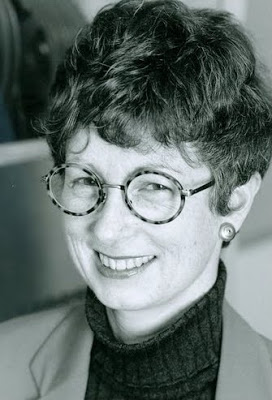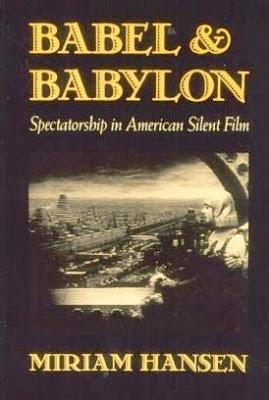Philosophy

 Miriam Hansen
Miriam Hansen
April 28th, 1949 to February 5th, 2011
"Miriam Hansen, a Scholar of Cinema, Dies at 61"
by
Margalit Fox
February 12th, 2011
The New York Times
Miriam Hansen, a scholar of cinema who studied not only film itself but also the early 20th-century creation known as the film audience, died on Feb. 5 in Chicago. She was 61 and a Chicago resident.
Her death, from cancer, was announced by the University of Chicago, where she was the Ferdinand Schevill distinguished service professor in the humanities. Professor Hansen also founded what is now the university’s cinema and media studies department.
If films are made to be seen, then they engender, in turn, particular ways of seeing. On these ways Professor Hansen trained her professional gaze. She was among the first film scholars to examine the viewing of film as a distinct cultural phenomenon — looking, in other words, at the art of looking.
Professor Hansen was known in particular for her book “Babel and Babylon: Spectatorship in American Silent Film,” published by Harvard University Press in 1991.
“She was in the first generation of scholars to see film viewing as a historically defined and shaped activity,” Daniel Morgan, an assistant professor of film studies at the University of Pittsburgh and a former doctoral student of Professor Hansen’s, said on Friday. “And also to understand that that meant we had to look at older films through the lens of the viewers they were intended for.”
Silent films were especially significant in this regard. For one thing, these films were all about watching: audiences of the period could scarcely have done anything else. For another, it was around the silents that a new demographic — the moviegoer — first coalesced.
Professor Hansen was deeply influenced by the Frankfurt School of social theory, a group of neo-Marxist thinkers of the 1930s that included Walter Benjamin and Theodor W. Adorno.
As she noted, early Hollywood films served as mass delivery systems for the capitalist and patriarchal worldviews of their producers. But at the same time, as she also noted, film audiences were strikingly democratic, bringing together people of various ages, ethnic backgrounds and social classes.
What was more, Professor Hansen argued, despite their mainstream ethos, early Hollywood films could contain quietly subversive elements. In the great silent screen star Rudolph Valentino — and in the cult of swooning moviegoers that sprang up around him, for instance — she saw a permissible outlet for the expression of women’s erotic desires, something traditionally considered taboo.
Dorothea Miriam Bratu was born in Offenbach, Germany, on April 28, 1949, the daughter of Jewish parents who had survived the war in exile and met afterward on returning to Germany.
In 1975, she earned a doctorate in American literature from Johann Wolfgang Goethe-Universität in Frankfurt, where she studied with Adorno and wrote her dissertation on Ezra Pound. She taught at Yale and Rutgers before joining the Chicago faculty in 1990.
After an early marriage that ended in divorce, Professor Hansen married Michael Geyer, a historian at Chicago, in 1991. He survives her, as does a brother, Micha Bratu.
Running through all of Professor Hansen’s work is a profound appreciation of early film as a Modernist medium, as Modernist in its way as Cubist painting. Unlike painting, though, it was also deeply populist. She coined the term “vernacular Modernism” to describe cinema’s place in the culture of the times.
“Both painting and film were linked in their responses to the modern world around them in the 1910s and ’20s,” Professor Morgan explained. “The example from the period that’s often given is that Chaplin does everything that Picasso does in terms of fragmentation of the human body, except that millions of people watch him every week, whereas only hundreds of people see Picasso.”

Babel and Babylon: Spectatorship in American Silent Film
by
Miriam Hansen
ISBN-10: 0674058313
ISBN-13: 978-0674058316
- Norway, Atheism, And The Nature Of Morality
One of the odd side stories around the tragic mass murder in Norway has been the lack of coverage in the American media given to the actions of Hege Dalen and Toril Hansen who heard the shooting, saw children trying to swim away from their attacker, and...
- Chaplin
Born from humble beginnings rooted in deplorable poverty and a broken home, Charles Spencer Chaplin would one day rise to worldwide prominence through the artistry of his comedic genius and the newly invented ability to disseminate information, art and...
- The Library Of Congress And Silent Films
"Library of Congress study sees troubling loss of silent feature films" The report commissioned by the National Film Preservation Board pinpoints the number of works that have survived. Some movies have been found abroad. by Susan King December 4th,...
- Deceased--amos Vogel
Amos Vogel April 18th, 1921 to April 24th, 2012 "Amos Vogel, Champion of Films, Dies at 91" by Bruce Weber April 28th, 2012 The New York TimesAmos Vogel, who exerted an influence on the history of film that few other non-filmmakers can claim, founding...
- Scientific Accuracy Of Science In The Cinema
All I can say is that we like exaggerations including the realms of science and such accurate cinema science would dilute the impact. Live with it, know the difference, and enjoy the film. "Make Science-Fiction Movies More Scientific, Says Scientist"...
Philosophy
Deceased--Miriam Hansen

 Miriam Hansen
Miriam HansenApril 28th, 1949 to February 5th, 2011
"Miriam Hansen, a Scholar of Cinema, Dies at 61"
by
Margalit Fox
February 12th, 2011
The New York Times
Miriam Hansen, a scholar of cinema who studied not only film itself but also the early 20th-century creation known as the film audience, died on Feb. 5 in Chicago. She was 61 and a Chicago resident.
Her death, from cancer, was announced by the University of Chicago, where she was the Ferdinand Schevill distinguished service professor in the humanities. Professor Hansen also founded what is now the university’s cinema and media studies department.
If films are made to be seen, then they engender, in turn, particular ways of seeing. On these ways Professor Hansen trained her professional gaze. She was among the first film scholars to examine the viewing of film as a distinct cultural phenomenon — looking, in other words, at the art of looking.
Professor Hansen was known in particular for her book “Babel and Babylon: Spectatorship in American Silent Film,” published by Harvard University Press in 1991.
“She was in the first generation of scholars to see film viewing as a historically defined and shaped activity,” Daniel Morgan, an assistant professor of film studies at the University of Pittsburgh and a former doctoral student of Professor Hansen’s, said on Friday. “And also to understand that that meant we had to look at older films through the lens of the viewers they were intended for.”
Silent films were especially significant in this regard. For one thing, these films were all about watching: audiences of the period could scarcely have done anything else. For another, it was around the silents that a new demographic — the moviegoer — first coalesced.
Professor Hansen was deeply influenced by the Frankfurt School of social theory, a group of neo-Marxist thinkers of the 1930s that included Walter Benjamin and Theodor W. Adorno.
As she noted, early Hollywood films served as mass delivery systems for the capitalist and patriarchal worldviews of their producers. But at the same time, as she also noted, film audiences were strikingly democratic, bringing together people of various ages, ethnic backgrounds and social classes.
What was more, Professor Hansen argued, despite their mainstream ethos, early Hollywood films could contain quietly subversive elements. In the great silent screen star Rudolph Valentino — and in the cult of swooning moviegoers that sprang up around him, for instance — she saw a permissible outlet for the expression of women’s erotic desires, something traditionally considered taboo.
Dorothea Miriam Bratu was born in Offenbach, Germany, on April 28, 1949, the daughter of Jewish parents who had survived the war in exile and met afterward on returning to Germany.
In 1975, she earned a doctorate in American literature from Johann Wolfgang Goethe-Universität in Frankfurt, where she studied with Adorno and wrote her dissertation on Ezra Pound. She taught at Yale and Rutgers before joining the Chicago faculty in 1990.
After an early marriage that ended in divorce, Professor Hansen married Michael Geyer, a historian at Chicago, in 1991. He survives her, as does a brother, Micha Bratu.
Running through all of Professor Hansen’s work is a profound appreciation of early film as a Modernist medium, as Modernist in its way as Cubist painting. Unlike painting, though, it was also deeply populist. She coined the term “vernacular Modernism” to describe cinema’s place in the culture of the times.
“Both painting and film were linked in their responses to the modern world around them in the 1910s and ’20s,” Professor Morgan explained. “The example from the period that’s often given is that Chaplin does everything that Picasso does in terms of fragmentation of the human body, except that millions of people watch him every week, whereas only hundreds of people see Picasso.”

Babel and Babylon: Spectatorship in American Silent Film
by
Miriam Hansen
ISBN-10: 0674058313
ISBN-13: 978-0674058316
- Norway, Atheism, And The Nature Of Morality
One of the odd side stories around the tragic mass murder in Norway has been the lack of coverage in the American media given to the actions of Hege Dalen and Toril Hansen who heard the shooting, saw children trying to swim away from their attacker, and...
- Chaplin
Born from humble beginnings rooted in deplorable poverty and a broken home, Charles Spencer Chaplin would one day rise to worldwide prominence through the artistry of his comedic genius and the newly invented ability to disseminate information, art and...
- The Library Of Congress And Silent Films
"Library of Congress study sees troubling loss of silent feature films" The report commissioned by the National Film Preservation Board pinpoints the number of works that have survived. Some movies have been found abroad. by Susan King December 4th,...
- Deceased--amos Vogel
Amos Vogel April 18th, 1921 to April 24th, 2012 "Amos Vogel, Champion of Films, Dies at 91" by Bruce Weber April 28th, 2012 The New York TimesAmos Vogel, who exerted an influence on the history of film that few other non-filmmakers can claim, founding...
- Scientific Accuracy Of Science In The Cinema
All I can say is that we like exaggerations including the realms of science and such accurate cinema science would dilute the impact. Live with it, know the difference, and enjoy the film. "Make Science-Fiction Movies More Scientific, Says Scientist"...
